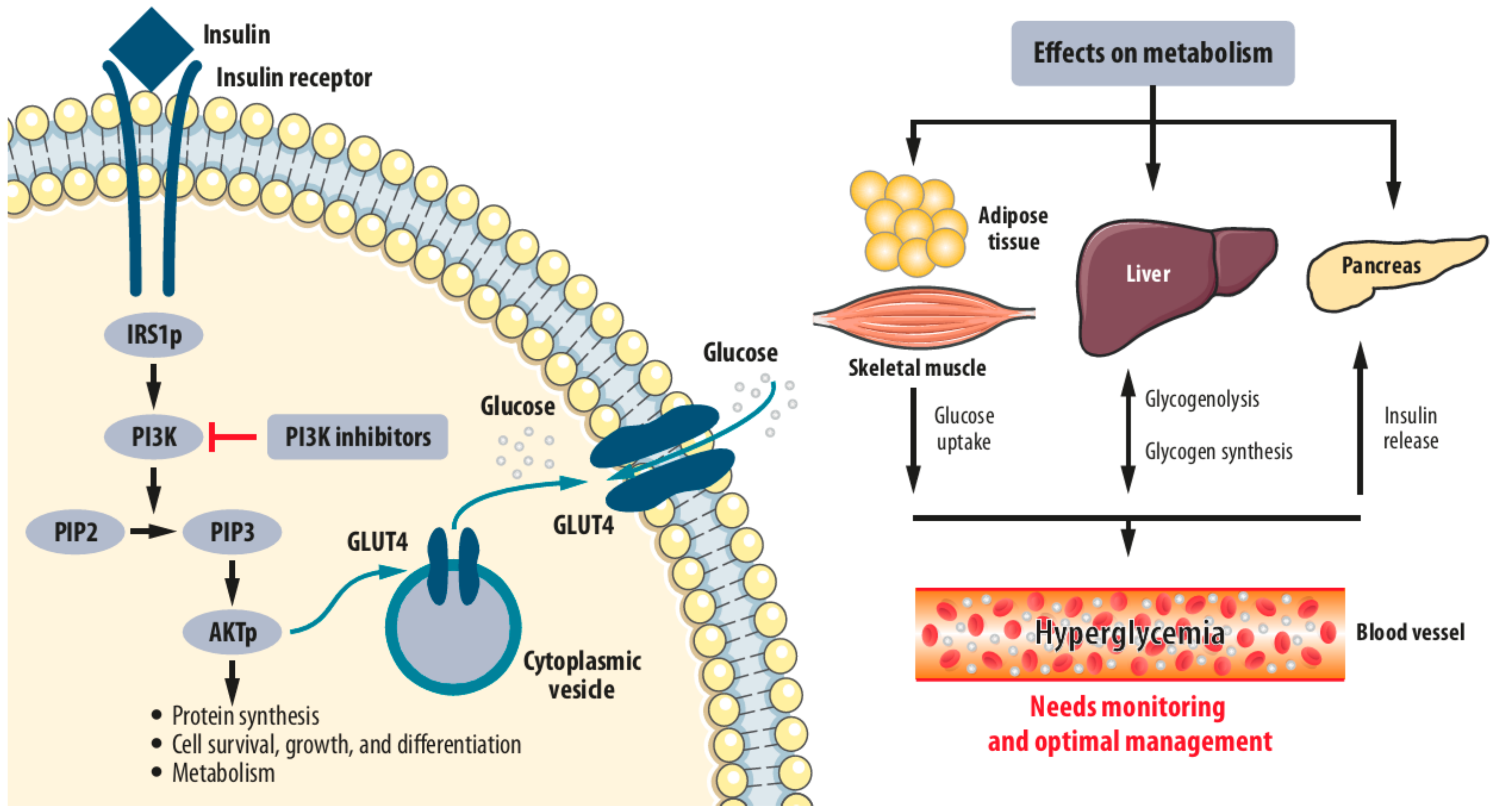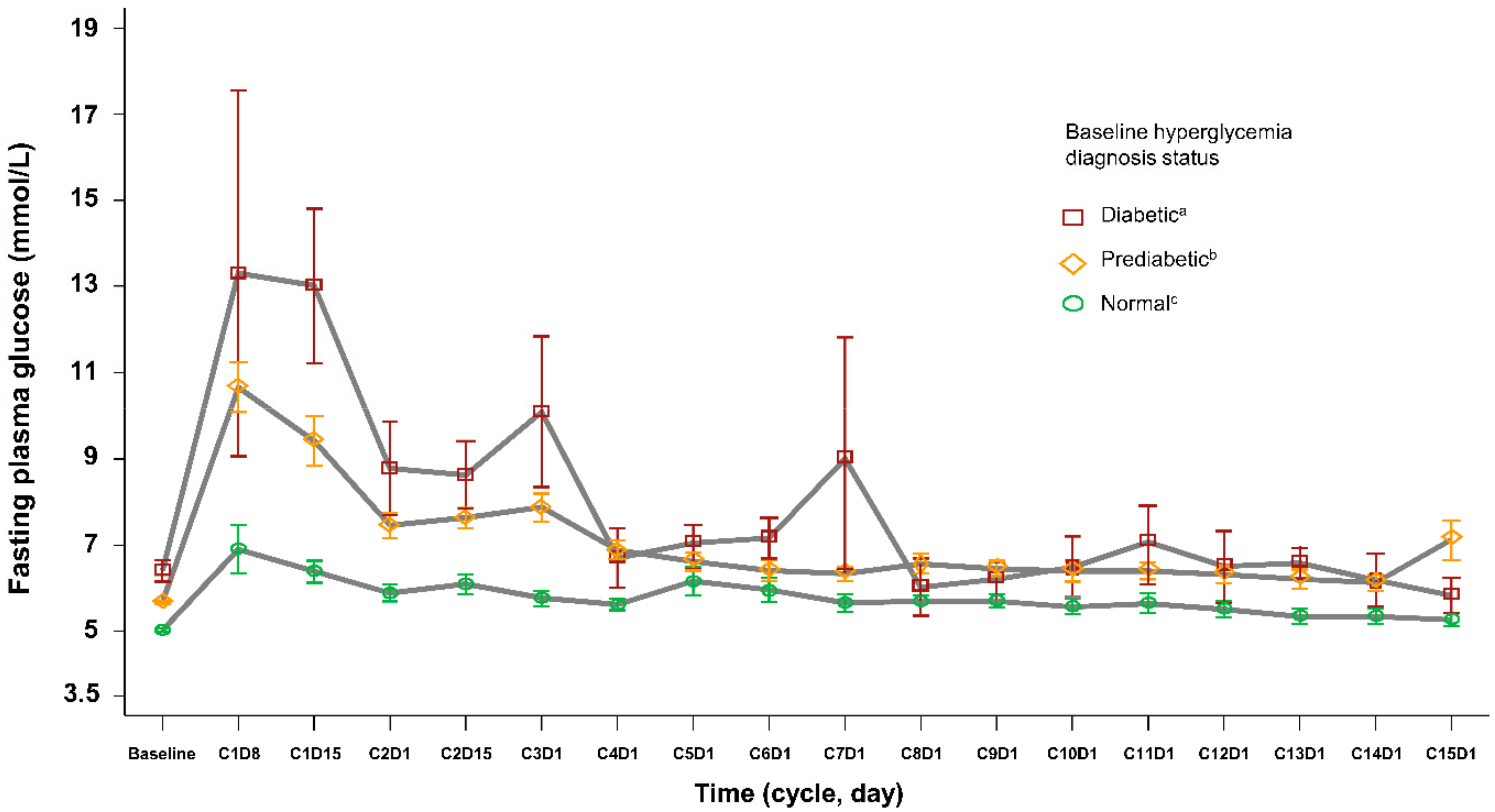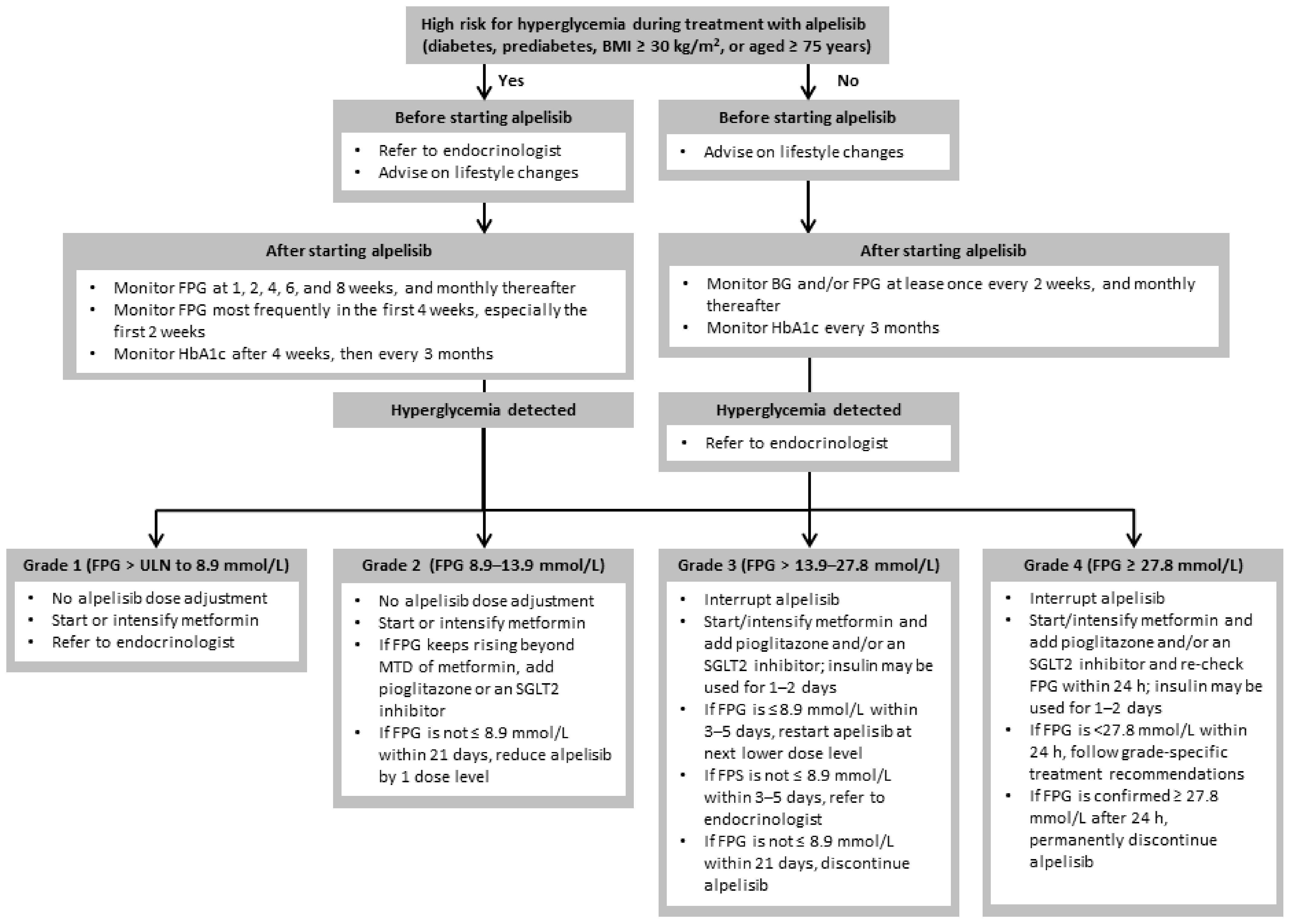Management Strategies for Hyperglycemia Associated with the α-Selective PI3K Inhibitor Alpelisib for the Treatment of Breast Cancer
Abstract
:Simple Summary
Abstract
1. Introduction
2. Methods and Data Sources
3. Preventive Management Strategies before Starting Alpelisib
3.1. Risk Assessment
3.2. Preventive Strategies
3.3. Education
4. Management Strategies during Alpelisib Treatment
4.1. Hyperglycemia Monitoring
4.2. Oral Antihyperglycemic Treatment
4.3. Insulin
5. Management Strategies after Alpelisib Treatment
6. Conclusions
Author Contributions
Funding
Acknowledgments
Conflicts of Interest
References
- Cardoso, F.; Paluch-Shimon, S.; Senkus, E.; Curigliano, G.; Aapro, M.S.; Andre, F.; Barrios, C.H.; Bergh, J.; Bhattacharyya, G.S.; Biganzoli, L.; et al. 5th ESO-ESMO international consensus guidelines for advanced breast cancer (ABC 5). Ann. Oncol. 2020, 31, 1623–1649. [Google Scholar] [CrossRef] [PubMed]
- National Comprehensive Cancer Network. NCCN Clinical Practice Guidelines in Oncology. Breast Cancer. V2.2019. Available online: https://www.nccn.org/professionals/physician_gls/pdf/breast.pdf (accessed on 15 April 2020).
- Hartkopf, A.D.; Grischke, E.M.; Brucker, S.Y. Endocrine-resistant breast cancer: Mechanisms and treatment. Breast. Care 2020, 15, 347–354. [Google Scholar] [CrossRef] [PubMed]
- O’Leary, B.; Cutts, R.J.; Liu, Y.; Hrebien, S.; Huang, X.; Fenwick, K.; Andre, F.; Loibl, S.; Loi, S.; Garcia-Murillas, I.; et al. The genetic landscape and clonal evolution of breast cancer resistance to palbociclib plus fulvestrant in the PALOMA-3 trial. Cancer Discov. 2018, 8, 1390–1403. [Google Scholar] [CrossRef] [PubMed] [Green Version]
- Turner, N.C.; Neven, P.; Loibl, S.; Andre, F. Advances in the treatment of advanced oestrogen-receptor-positive breast cancer. Lancet 2017, 389, 2403–2414. [Google Scholar] [CrossRef]
- Goncalves, M.D.; Hopkins, B.D.; Cantley, L.C. Phosphatidylinositol 3-kinase, growth disorders, and cancer. N. Engl. J. Med. 2018, 379, 2052–2062. [Google Scholar] [CrossRef]
- Martinez-Saez, O.; Chic, N.; Pascual, T.; Adamo, B.; Vidal, M.; Gonzalez-Farre, B.; Sanfeliu, E.; Schettini, F.; Conte, B.; Braso-Maristany, F.; et al. Frequency and spectrum of PIK3CA somatic mutations in breast cancer. Breast Cancer Res. 2020, 22, 45. [Google Scholar] [CrossRef]
- Cancer Genome Atlas Network. Comprehensive molecular portraits of human breast tumours. Nature 2012, 490, 61–70. [Google Scholar] [CrossRef] [Green Version]
- Andre, F.; Ciruelos, E.; Rubovszky, G.; Campone, M.; Loibl, S.; Rugo, H.S.; Iwata, H.; Conte, P.; Mayer, I.A.; Kaufman, B.; et al. Alpelisib for PIK3CA-mutated, hormone receptor-positive advanced breast cancer. N. Engl. J. Med. 2019, 380, 1929–1940. [Google Scholar] [CrossRef]
- Miller, T.W.; Balko, J.M.; Arteaga, C.L. Phosphatidylinositol 3-kinase and antiestrogen resistance in breast cancer. J. Clin. Oncol. 2011, 29, 4452–4461. [Google Scholar] [CrossRef] [Green Version]
- Mosele, F.; Stefanovska, B.; Lusque, A.; Tran Dien, A.; Garberis, I.; Droin, N.; Le Tourneau, C.; Sablin, M.P.; Lacroix, L.; Enrico, D.; et al. Outcome and molecular landscape of patients with PIK3CA-mutated metastatic breast cancer. Ann. Oncol. 2020, 31, 377–386. [Google Scholar] [CrossRef] [Green Version]
- Sobhani, N.; Roviello, G.; Corona, S.P.; Scaltriti, M.; Ianza, A.; Bortul, M.; Zanconati, F.; Generali, D. The prognostic value of PI3K mutational status in breast cancer: A meta-analysis. J. Cell. Biochem. 2018, 119, 4287–4292. [Google Scholar] [CrossRef] [PubMed]
- Andre, F.; Ciruelos, E.M.; Juric, D.; Loibl, S.; Campone, M.; Mayer, I.A.; Rubovszky, G.; Yamashita, T.; Kaufman, B.; Lu, Y.S.; et al. Alpelisib plus fulvestrant for PIK3CA-mutated, hormone receptor-positive, human epidermal growth factor receptor-2-negative advanced breast cancer: Final overall survival results from SOLAR-1. Ann. Oncol. 2021, 32, 208–217. [Google Scholar] [CrossRef] [PubMed]
- Fritsch, C.; Huang, A.; Chatenay-Rivauday, C.; Schnell, C.; Reddy, A.; Liu, M.; Kauffmann, A.; Guthy, D.; Erdmann, D.; De Pover, A.; et al. Characterization of the novel and specific PI3Kalpha inhibitor NVP-BYL719 and development of the patient stratification strategy for clinical trials. Mol. Cancer Ther. 2014, 13, 1117–1129. [Google Scholar] [CrossRef] [Green Version]
- O’Brien, N.A.; McDermott, M.S.J.; Conklin, D.; Luo, T.; Ayala, R.; Salgar, S.; Chau, K.; DiTomaso, E.; Babbar, N.; Su, F.; et al. Targeting activated PI3K/mTOR signaling overcomes acquired resistance to CDK4/6-based therapies in preclinical models of hormone receptor-positive breast cancer. Breast Cancer Res. 2020, 22, 89. [Google Scholar] [CrossRef] [PubMed]
- Rugo, H.S.; Lerebours, F.; Ciruelos, E.; Drullinsky, P.; Ruiz, M.; Borrego, M.R.; Neven, P.; Park, Y.H.; Prat, A.; Bachelot, T.; et al. Alpelisib + fulvestrant in patients with PIK3CA5 mutated hormone-receptor positive (HR+), human epidermal growth factor receptor-2-negative (HER2−) advanced breast cancer (ABC) previously treated with cyclin-dependent kinase 4/6 inhibitor (CDKi) + aromatase inhibitor (AI): BYLieve study results. J. Clin. Oncol. 2020, 38 (Suppl. 15), 1006. [Google Scholar] [CrossRef]
- Rugo, H.S.; Andre, F.; Yamashita, T.; Cerda, H.; Toledano, I.; Stemmer, S.M.; Jurado, J.C.; Juric, D.; Mayer, I.; Ciruelos, E.M.; et al. Time course and management of key adverse events during the randomized phase III SOLAR-1 study of PI3K inhibitor alpelisib plus fulvestrant in patients with HR-positive advanced breast cancer. Ann. Oncol. 2020, 31, 1001–1010. [Google Scholar] [CrossRef]
- Rugo, H.S.; Lerebours, F.; Juric, D.; Turner, N.C.; Chia, S.K.L.; Drullinsky, P.; Prat, A.; Villanueva Vazquez, R.; Akdere, M.; Arce, C.; et al. Alpelisib + letrozole in patients with PIK3CA5 mutated hormone-receptor positive (HR+), human epidermal growth factor receptor-2-negative (HER2–) advanced breast cancer (ABC) previously treated with cyclin-dependent kinase 4/6 inhibitor (CDKi) + fluvestrant: BYLieve study results. Cancer Res. 2021, 81, PD2-07. [Google Scholar]
- Baselga, J.; Im, S.A.; Iwata, H.; Cortes, J.; De Laurentiis, M.; Jiang, Z.; Arteaga, C.L.; Jonat, W.; Clemons, M.; Ito, Y.; et al. Buparlisib plus fulvestrant versus placebo plus fulvestrant in postmenopausal, hormone receptor-positive, HER2-negative, advanced breast cancer (BELLE-2): A randomised, double-blind, placebo-controlled, phase 3 trial. Lancet Oncol. 2017, 18, 904–916. [Google Scholar] [CrossRef]
- Di Leo, A.; Johnston, S.; Lee, K.S.; Ciruelos, E.; Lonning, P.E.; Janni, W.; O’Regan, R.; Mouret-Reynier, M.A.; Kalev, D.; Egle, D.; et al. Buparlisib plus fulvestrant in postmenopausal women with hormone-receptor-positive, HER2-negative, advanced breast cancer progressing on or after mTOR inhibition (BELLE-3): A randomised, double-blind, placebo-controlled, phase 3 trial. Lancet Oncol. 2018, 19, 87–100. [Google Scholar] [CrossRef]
- Janku, F.; Yap, T.A.; Meric-Bernstam, F. Targeting the PI3K pathway in cancer: Are we making headway? Nat. Rev. Clin. Oncol. 2018, 15, 273–291. [Google Scholar] [CrossRef]
- Shields, M.; Mo, Q.; Armitage, M.; Sharpe, S.C.; Costa, R.L.B. A systematic review and meta-analysis of selected toxicity endpoints of alpelisib. Oncotarget 2020, 11, 3793–3799. [Google Scholar] [CrossRef] [PubMed]
- Nunnery, S.E.; Mayer, I.A. Management of toxicity to isoform alpha-specific PI3K inhibitors. Ann. Oncol. 2019, 30 (Suppl. 10), x21–x26. [Google Scholar] [CrossRef] [PubMed]
- Anders, C.K.; LeBoeuf, N.R.; Bashoura, L.; Faiz, S.A.; Shariff, A.I.; Thomas, A. What’s the price? Toxicities of targeted therapies in breast cancer care. Am. Soc. Clin. Oncol. Educ. Book 2020, 40, 55–70. [Google Scholar] [CrossRef]
- Fruman, D.A.; Chiu, H.; Hopkins, B.D.; Bagrodia, S.; Cantley, L.C.; Abraham, R.T. The PI3K pathway in human disease. Cell 2017, 170, 605–635. [Google Scholar] [CrossRef] [PubMed] [Green Version]
- Katso, R.; Okkenhaug, K.; Ahmadi, K.; White, S.; Timms, J.; Waterfield, M.D. Cellular function of phosphoinositide 3-kinases: Implications for development, homeostasis, and cancer. Annu. Rev. Cell Dev. Biol. 2001, 17, 615–675. [Google Scholar] [CrossRef]
- Knight, Z.A.; Gonzalez, B.; Feldman, M.E.; Zunder, E.R.; Goldenberg, D.D.; Williams, O.; Loewith, R.; Stokoe, D.; Balla, A.; Toth, B.; et al. A pharmacological map of the PI3-K family defines a role for p110alpha in insulin signaling. Cell 2006, 125, 733–747. [Google Scholar] [CrossRef] [PubMed] [Green Version]
- Hopkins, B.D.; Pauli, C.; Du, X.; Wang, D.G.; Li, X.; Wu, D.; Amadiume, S.C.; Goncalves, M.D.; Hodakoski, C.; Lundquist, M.R.; et al. Suppression of insulin feedback enhances the efficacy of PI3K inhibitors. Nature 2018, 560, 499–503. [Google Scholar] [CrossRef] [Green Version]
- Qiu, J.; Zheng, Q.; Meng, X. Hyperglycemia and chemoresistance in breast cancer: From cellular mechanisms to treatment response. Front. Oncol. 2021, 11, 628359. [Google Scholar] [CrossRef]
- European Medicines Agency. Piqray (Alpelisib) [Summary of Product Characteristics]. Available online: https://www.ema.europa.eu/en/documents/product-information/piqray-epar-product-information_en.pdf (accessed on 15 April 2020).
- US Food and Drug Administration. Piqray® (Alpelisib) Tablets, for Oral Use [Prescribing Information]. Available online: https://www.accessdata.fda.gov/drugsatfda_docs/label/2019/212526s000lbl.pdf (accessed on 15 April 2019).
- American Diabetes Association. 3. Prevention or delay of type 2 diabetes: Standards of Medical Care in Diabetes–2019. Diabetes Care 2019, 42, S29–S33. [Google Scholar] [CrossRef] [Green Version]
- American Diabetes Association. 5. Lifestyle management: Standards of Medical Care in Diabetes–2019. Diabetes Care 2019, 42, S46–S60. [Google Scholar] [CrossRef] [Green Version]
- Noch, E.; Yin, I.; Cantley, L. EXTH-36. PI3K inhibition in conjunction with the ketogenic diet reduces growth and neuroinflammation in pediatric high-grade glioma. Neuro-Oncology 2019, 21, vi89. [Google Scholar] [CrossRef]
- Zou, Y.; Fineberg, S.; Pearlman, A.; Feinman, R.D.; Fine, E.J. The effect of a ketogenic diet and synergy with rapamycin in a mouse model of breast cancer. PLoS ONE 2020, 15, e0233662. [Google Scholar] [CrossRef] [PubMed]
- Pollak, M. Diet boosts the effectiveness of a cancer drug. Nature 2018, 560, 439–440. [Google Scholar] [CrossRef] [PubMed]
- Grandl, G.; Straub, L.; Rudigier, C.; Arnold, M.; Wueest, S.; Konrad, D.; Wolfrum, C. Short-term feeding of a ketogenic diet induces more severe hepatic insulin resistance than an obesogenic high-fat diet. J. Physiol. 2018, 596, 4597–4609. [Google Scholar] [CrossRef]
- American Diabetes Association. 9. Pharmacologic approaches to glycemic treatment: Standards of Medical Care in Diabetes–2019. Diabetes Care 2019, 42, S90–S102. [Google Scholar] [CrossRef] [Green Version]
- Davies, M.J.; D’Alessio, D.A.; Fradkin, J.; Kernan, W.N.; Mathieu, C.; Mingrone, G.; Rossing, P.; Tsapas, A.; Wexler, D.J.; Buse, J.B. Management of hyperglycaemia in type 2 diabetes, 2018. A consensus report by the American Diabetes Association (ADA) and the European Association for the Study of Diabetes (EASD). Diabetologia 2018, 61, 2461–2498. [Google Scholar] [CrossRef] [Green Version]
- Moin, T.; Schmittdiel, J.A.; Flory, J.H.; Yeh, J.; Karter, A.J.; Kruge, L.E.; Schillinger, D.; Mangione, C.M.; Herman, W.H.; Walker, E.A. Review of metformin use for type 2 diabetes prevention. Am. J. Prev. Med. 2018, 55, 565–574. [Google Scholar] [CrossRef]
- Knowler, W.C.; Barrett-Connor, E.; Fowler, S.E.; Hamman, R.F.; Lachin, J.M.; Walker, E.A.; Nathan, D.M.; Diabetes Prevention Program Research Group. Reduction in the incidence of type 2 diabetes with lifestyle intervention or metformin. N. Engl. J. Med. 2002, 346, 393–403. [Google Scholar]
- American Diabetes Association. Standards of medical care in diabetes—2014. Diabetes Care 2015, 38, S31–S33. [Google Scholar]
- Aljofan, M.; Riethmacher, D. Anticancer activity of metformin: A systematic review of the literature. Future Sci. OA 2019, 5, FSO410. [Google Scholar] [CrossRef] [Green Version]
- Burnette, S.; Poehlein, E.; Lee, H.-J.; Force, J.; Westbrook, K.; Moore, H. Risk factor (RF) identification (ID) and hyperglycemia (HG) prevention with alpelisib (ALP) + fulvestrant (FLV) in PIK3CA-mutated, hormone-receptor positive (HR+), human epidermal growth factor-2 negative (HER2−) advanced breast cancer (ABC). Ann. Oncol. 2021, 32, S470. [Google Scholar] [CrossRef]
- Busaidy, N.L.; Farooki, A.; Dowlati, A.; Perentesis, J.P.; Dancey, J.E.; Doyle, L.A.; Brell, J.M.; Siu, L.L. Management of metabolic effects associated with anticancer agents targeting the PI3K-Akt-mTOR pathway. J. Clin. Oncol. 2012, 30, 2919–2928. [Google Scholar] [CrossRef] [PubMed] [Green Version]
- Perry, R.J.; Shulman, G.I. Sodium-glucose cotransporter-2 inhibitors: Understanding the mechanisms for therapeutic promise and persisting risks. J. Biol. Chem. 2020, 295, 14379–14390. [Google Scholar] [CrossRef] [PubMed]
- Park, J.; Shin, S.W. Alpelisib for PIK3CA-mutated advanced breast cancer. N. Engl. J. Med. 2019, 381, 686. [Google Scholar]
- Flory, J.; Lipska, K. Metformin in 2019. JAMA 2019, 321, 1926–1927. [Google Scholar] [CrossRef]
- Bonnet, F.; Scheen, A. Understanding and overcoming metformin gastrointestinal intolerance. Diabetes Obes. Metab. 2017, 19, 473–481. [Google Scholar] [CrossRef]
- Olgun, A. “Metformin-resistant” folic acid producing probiotics or folic acid against metformin’s adverse effects like diarrhea. Med. Hypotheses 2017, 106, 33–34. [Google Scholar] [CrossRef]
- Staels, B. Metformin and pioglitazone: Effectively treating insulin resistance. Curr. Med. Res. Opin. 2006, 22 (Suppl. 2), S27–S37. [Google Scholar] [CrossRef]
- Alam, F.; Islam, M.A.; Mohamed, M.; Ahmad, I.; Kamal, M.A.; Donnelly, R.; Idris, I.; Gan, S.H. Efficacy and safety of pioglitazone monotherapy in type 2 diabetes mellitus: A systematic review and meta-analysis of randomised controlled trials. Sci. Rep. 2019, 9, 5389. [Google Scholar] [CrossRef] [Green Version]
- Lu, Y.; Chiu, J.; Airoldi, M.; Margeli Vila, M.; Ponce Lorenzo, J.; Ghaznawi, F.; Guadenzi, F.; Ridolfi, A.; Lorenzo, I.; Ruiz Borrego, M. Sodium-glucose cotransporter-2 (SGLT-2) inhibitors for alpelisib (ALP)-induced hyperglycemia: A report of 6 cases from SOLAR-1 [301P]. Ann. Oncol. 2020, 31, S363. [Google Scholar] [CrossRef]
- Andre, F.; Mills, D.; Taran, T. Alpelisib for PIK3CA-mutated advanced breast cancer. Reply. N. Engl. J. Med. 2019, 381, 687. [Google Scholar]
- Juric, D.; Rodon, J.; Tabernero, J.; Janku, F.; Burris, H.A.; Schellens, J.H.M.; Middleton, M.R.; Berlin, J.; Schuler, M.; Gil-Martin, M.; et al. Phosphatidylinositol 3-kinase alpha-selective inhibition with alpelisib (BYL719) in PIK3CA-altered solid tumors: Results from the first-in-human study. J. Clin. Oncol. 2018, 36, 1291–1299. [Google Scholar] [CrossRef] [PubMed]
- Farah, S.J.; Masri, N.; Ghanem, H.; Azar, M. Diabetic ketoacidosis associated with alpelisib treatment of metastatic breast cancer. AACE Clin. Case Rep. 2020, 6, e349–e351. [Google Scholar] [CrossRef] [PubMed]



| Management Task | Recommendations |
|---|---|
| Oncologist-performed risk assessment | Assess risk of alpelisib-induced hyperglycemia based on:
Diabetes: FPG ≥ 7.0 mmol/L (≥126 mg/dL), HbA1c ≥ 6.5%
|
| Endocrinologist/diabetologist consultation | Refer patients with prediabetes or diabetes to an endocrinologist/diabetologist Optimize the patient’s level of blood glucose |
| Lifestyle advice | Advise a sugar-free, fiber-rich diet with moderate carbohydrate intake (~200 g or ~30–40% of daily calories), and principally complex carbohydrates
|
| Prophylactic medication | Metformin may be used for prevention of alpelisib-induced hyperglycemia, but there is currently no supporting evidence for this practice |
| Education | Educate patients and caregivers, GPs, oncologists, and endocrinologists/diabetologists on the risk and appropriate management of alpelisib-induced hyperglycemia |
| Treatment | Recommendations |
|---|---|
| Oral antihyperglycemic treatment | If hyperglycemia is detected (FPG > 7 mmol/L (>126 mg/dL)), an oral antihyperglycemic drug should be prescribed Evaluation of renal function, body weight, and other comorbidities before initiating antihyperglycemic treatment is important Based on oral antihyperglycemic drugs’ mechanisms of action and AEs, and on the pathophysiology of alpelisib-induced hyperglycemia, 3 groups of drugs should be preferentially considered:
Consider discontinuation with gradual re-challenge 4–5 days later, starting with half an 850 mg tablet after dinner
For grade 3 hyperglycemia b, if ketones negative, up-titrate metformin from 500 to 2000 mg in combination with a second-line drug (pioglitazone or SGLT2 inhibitor), or a combination of metformin, pioglitazone, and a SGLT2 inhibitor For grade 4 hyperglycemia c, if ketones negative, maximize oral antihyperglycemic therapy (metformin 2000 mg, pioglitazone 45 mg, and maximal dose SGLT2 inhibitor) |
| Insulin | Avoid if possible, but insulin can be used as rescue medication for 1–2 days until hyperglycemia resolves d Insulin should be initiated in cases of uncontrolled severe hyperglycemia, ketoacidosis, failure of non-insulin antihyperglycemic therapy, or concomitant acute illness In cases of grade 3/4 hyperglycemia, check ketones, and if positive, discontinue oral agents and start insulin |
Publisher’s Note: MDPI stays neutral with regard to jurisdictional claims in published maps and institutional affiliations. |
© 2022 by the authors. Licensee MDPI, Basel, Switzerland. This article is an open access article distributed under the terms and conditions of the Creative Commons Attribution (CC BY) license (https://creativecommons.org/licenses/by/4.0/).
Share and Cite
Tankova, T.; Senkus, E.; Beloyartseva, M.; Borštnar, S.; Catrinoiu, D.; Frolova, M.; Hegmane, A.; Janež, A.; Krnić, M.; Lengyel, Z.; et al. Management Strategies for Hyperglycemia Associated with the α-Selective PI3K Inhibitor Alpelisib for the Treatment of Breast Cancer. Cancers 2022, 14, 1598. https://doi.org/10.3390/cancers14071598
Tankova T, Senkus E, Beloyartseva M, Borštnar S, Catrinoiu D, Frolova M, Hegmane A, Janež A, Krnić M, Lengyel Z, et al. Management Strategies for Hyperglycemia Associated with the α-Selective PI3K Inhibitor Alpelisib for the Treatment of Breast Cancer. Cancers. 2022; 14(7):1598. https://doi.org/10.3390/cancers14071598
Chicago/Turabian StyleTankova, Tsvetalina, Elżbieta Senkus, Maria Beloyartseva, Simona Borštnar, Doina Catrinoiu, Mona Frolova, Alinta Hegmane, Andrej Janež, Mladen Krnić, Zoltan Lengyel, and et al. 2022. "Management Strategies for Hyperglycemia Associated with the α-Selective PI3K Inhibitor Alpelisib for the Treatment of Breast Cancer" Cancers 14, no. 7: 1598. https://doi.org/10.3390/cancers14071598
APA StyleTankova, T., Senkus, E., Beloyartseva, M., Borštnar, S., Catrinoiu, D., Frolova, M., Hegmane, A., Janež, A., Krnić, M., Lengyel, Z., Marcou, Y., Mazilu, L., Mrinakova, B., Percik, R., Petrakova, K., Rubovszky, G., Tokar, M., & Vrdoljak, E. (2022). Management Strategies for Hyperglycemia Associated with the α-Selective PI3K Inhibitor Alpelisib for the Treatment of Breast Cancer. Cancers, 14(7), 1598. https://doi.org/10.3390/cancers14071598







